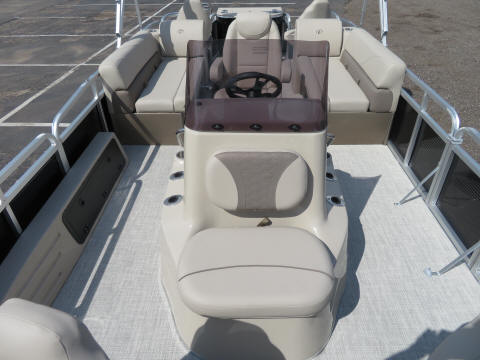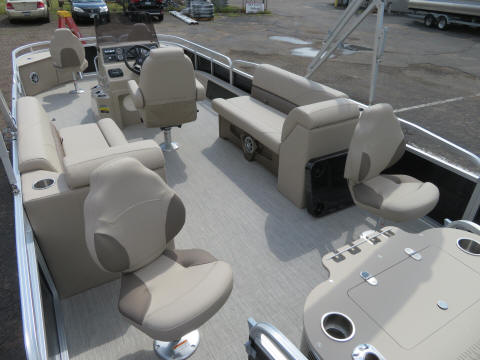
How to Buy the Right Pontoon
With so many choices in the New Pontoon and Used Pontoon market, finding the pontoon that is right for you can be a difficult decision. There are many questions to ask when shopping for a pontoon. Learning about Pontoon features and designs will narrow down the search. Here are some questions to ask yourself when buying a Pontoon.
What are you planning to do with the Pontoon?
Pontoons have many uses and create an enjoyable atmosphere. Choose from options below when deciding what to do with your pontoon.
Will You be Fishing on the Pontoon?
Choose from links below to learn about fish model Pontoons.
- What makes a Pontoon a Fishing Pontoon?
- What is the best pontoon for both fishing and relaxing?
- What is a 4-Corner Fish Model Pontoon?
- What is a Center Console Fishing Pontoon?
- What is a Front Fish and Cruise Pontoon?
- What is a Rear Fish and Cruise Pontoon?
Do You want to Tube or Ski Behind a Pontoon?
Choose links below to learn about Pontoon Performance.
- What does a pontoon need to go Tubing or Ski?
- How much Horse power does the pontoon need for tubing or skiing?
- What kind of power does the pontoon need for tubing or skiing?
- Do I need a Tri-Toon Pontoon?
What Size Pontoon is Best?
Choose links below to learn about Pontoon Sizes.
- What are common Pontoon Sizes?
- What are common pontoon tube layout?
- What are questions to ask about getting the right size pontoon?
- How many people will fit on the typical pontoon?
Le Will Be on the Pontoon?
- Do you want to tube or ski with your Pontoon?
- Do you need to have a portable bathroom on your Pontoon?
- What is the best trailer for a Pontoon?
- Do you want to have an area to relax on your fishing Pontoon?
Fishing Pontoons
Will you be fishing from the pontoon? The fish don't care if your new pontoon is set up for fishing, but you may. A typical fish model pontoon will have at least a pair of chairs that individuals can sit on comfortably while fishing. Fish model pontoons offer open spaces for moving around and accessing multiple sides of the boat for landing fish. Typically there is at least one livewell to keep fish or bait in. Here is a list of a few common layouts for fishing pontoons.
4-Corner Fishing Pontoon
Do you want a pontoon the is best for fishing off of all sides? A four corner fish model is an excellent choice for maximizing fishing access from both the front and the rear. Most 4 corner fish model pontoons feature a rear livewell. Some models of 4 Corner Fish Pontoons also have a second front Livewell. Four Corner Fish Model pontoons come in many sizes. 20' long pontoons are the most common 4-corner fish pontoon in the midwest.
-
Front View of a 4 Corner Fish Pontoon

-
Rear View of a Four Corner Fish Model Pontoon

Center Console Fishing Pontoon
The Ultimate Fisherman's Experience Features 360 Degree Fishing access from a Pontoon. Center Console Fish Pontoons Feature a control helm located mid ship with access to the both starboard and port sides Center Console Fishing pontoons typically include multiple pedestal seats for fishing front he front or rear, possibly a lounging area, rod holder, and at least one livewell. Center console fish pontoons are ready to hit larger water ways and grab the big fish.
-
Front View of a Center Console Fish Pontoon

-
Center Console Fishing Console

-
Rear View of a Center Console Fish Model Pontoon

Fish and Cruise Pontoons
Looking for a Pontoon that is for fishing and relaxing? A fish and cruise pontoon will typically get you the benefits of both a fish model pontoon and a classic cruising pontoon. The fishing benefits of a fish and cruise pontoon include pedestal seating, a live well, rod holders and often a fish finder. The cruising aspect of the pontoon gets the comfortable interior to lounge and relax in. Typical fish and cruise pontoons have pedestal seats in either the front and back, and then at least one lounges area. There are a few common fish and cruise pontoon layouts to choose from. Click below to choose from:
Front Fish and Cruise Pontoon
Rear Fish and Cruise Pontoon
Front Fish, Rear Lounge
Front fish, Rear lounge pontoon allows for easy fishing access up front, but also provides the pontoon passengers to lounge out on a classic rear couch. Typically a front fish model will include a livewell in the forward fishing area. The rear may feature wrap around seating, and maybe even pop up changing station. Common Front fish Pontoon sizes range from 18'-24' in Minnesota.
(This Princecraft pontoon has bonus front seating behind the front fishing seats)
-
Forward View of a Front Fishing Pontoon

-
Rear View of a Front Fishing Pontoon

Rear Fishing and Front Cruising Pontoon
The Midwest's Most Popular Fishing Pontoon Layout is the Rear Fish model with Front Cruise. Featuring a pair of front lounge seats, a wrap around couch plus a pair of chairs at the rear fish station, the fish and cruise model offers great space for entertaining and fishing. This layout gets the pontoon owner 3 zones of seating, plus the rear fishing chairs can double as spotter chairs for watching tubers and skiers. Common Front fish Pontoon sizes range from 18'-24' in Minnesota. The Number one Pontoon Layout people are buying at Boat World is a 22' Fish and Cruise.
-
Front View of a Rear Fish and Cruise

-
Rear View of Fish and Cruise Pontoon

Pontoon Sizes
Most pontoons will range from 14' to 28' feet in length. Width's of pontoons are typically 7' wide to 8' 6" wide. There are manufacturers building narrower and wider pontoons than the typical sizes; however, they are more rare. Depending on the region of the country, common sizes of pontoons can vary. The most common size new pontoon sold at Boat World in Minnesota is a 22' long 8' 6" wide Pontoon. The most popular used pontoon for sale at Boat World is 20' Long Boat. When shopping for a new pontoon it is important to get the actual size of the deck length and the width of the pontoon. Often new pontoon manufactures label the pontoon in such a was as to mask actually sizes. Many price leader pontoons feature narrow 8' wide beams and are typically under 20' long. Pontoon Boats with 8' 6" wide beams offer the availability for a larger seating and walking area. Narrow pontoons can often be harder to move about while inside. The other determination to make in pontoon purchasing is what size floats to get. Most pontoons standard with floats are 23" wide. Upgrades sizes (25" or larger) give the pontoon a better ride and performance. The size of a pontoon and it floats will affect the capacity of engine size, gross weight, and people.
Questions to ask when choosing the right pontoon size:
Below are some common questions to answer when determining what size pontoon to purchase.
- How many people do you want to have on the pontoon?
- What kind of speed and power do you expect from your pontoon?
- Where is the pontoon going to be stored in summer and winter?
- What if you have an existing Pontoon Lift to use with the Pontoon?
How many people can fit on the pontoon?
Capacity of a pontoon is determined by a manufactures formula calculated in conjunction with the U.S. coast guard. Not all manufacturers rate pontoons the same so capacities can vary. Tube sizes and quantity (tri-toon vs two tube boat) also can change capacities. Size of p Typical capacities may be as follows:
- 16' pontoons typically hold 6 people
- 18' pontoons typically hold 6-8 people
- 20' pontoons typically hold 9-12 people
- 22' pontoons typically hold 11-14 people
- 24' pontoons typically hold 12-15 people
- 26' pontoons typically hold 13-16 people
How do I tube or ski behind a pontoon?
Riding behind a pontoon on an Inflatable tube or with skis can be a fun time. The amount of excitement you are looking for is greatly affected by the power and size of the pontoon and motor. A pontoon can pull a tuber with a small motor. Even a 25hp motor will slowly move a tube, but if you are looking for more excitement a larger motor is suggested. 60hp outboards on pontoons typically do not go over 20mph with a number of people on board. A slow tube experience will be fine with a 60hp outboard.
To get a good full speed experience tubing with a pontoon, a 90hp plus motor is suggested. 115hp Outboard on pontoons typically can go over 25mph and sometimes into the low 30mph range. 115Hp is an excellent choice for tubing behind most pontoon sizes. For skier, more power is needed. The experienced skier may pop up out of the water quickly, but for many skier the pontoon will need to have enough thrust to quickly move them up and out of the water. Some Pontoon skier have good luck starting a 115HP. A 150hp -250hp is ideal for pontoon skiing. To attach a tuber or skier to a pontoon you will need the proper safe ropes, connection hardware mounting points and tie down. Some pontoons will come with an optional ski tow bar. Often a pontoon can also have a ski tow bar installed at the dealer. The two common style pontoon ski tow bars are a deck mount or transom mount. For boats without tow bars, some water sports are done by attaching ropes to the rear transom mounts welded to the pontoon floats. Pontoon ski tow bars are pictured below.
-
Deck Mounted Pontoon Ski Tow Bar

-
Transom Mounted Pontoon Ski Tow Bar

Withs of most pontoons will range from 14' to 28' feet in length. Width's of pontoons are typically 7' wide to 8' 6" wide. There are manufactures with smaller and larger size pontoons.
